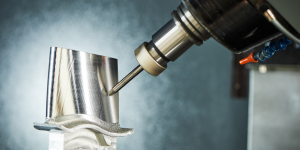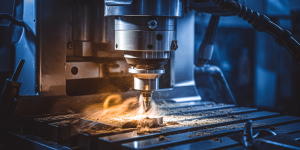CNC milling uses copper in many industries. It shapes and cuts copper by using CNC machines. This method is accurate, time-saving, and low-cost. Copper is a very conductive metal used in most electrical and electronic applications. Its high thermal conductivity is beneficial to heat sinks and cooling systems. Copper is difficult to work with due to its hardness and the underlying tool wear.
Correct selection of tools and lubricant is essential for smooth milling. When designing components or products that use copper attributes like electrical conductivity and corrosion resistance, you should understand the following. If you are a manufacturer or engineer, effective know-how about material qualities and machining processes is essential in achieving excellent results on copper CNC-frezen projects.
1. What is copper CNC milling?
Numerical control enables CNC milling of copper shapes and metal cutting. It is used in aviation, automobile, elektronica, and telecoms. A rotating multi-toothed cutter can be used in order to remove material from the workpiece and create the required shape, size, enzovoort. Copper CNC machining provides accurate and stable cutting of intricate shapes.
CNC machines are much more precise than manual milling. Copper finds use in electrical and heat transfer because of its conductivity, and corrosion resistance. Copper CNC machining creates intricate, accurate copper pieces.
2. Why choose copper CNC milling?
Copper CNC machining is special in several aspects. Its high thermal conductivity makes it suitable in use as a heat sink and also electrical components. Since copper is noncorrosive, machined parts of it do not wear out so easily. Copper is a good conductor of electricity and as such it makes great use in electronics and telecommunications.

Since copper is ductile and malleable, it makes an ideal metal for making complicated pieces. Copper is at an affordable price and abundant which makes copper CNC machining cost-efficient. Copper CNC machining is low cost, versatile, and high performance but at the same time reliable.
3. How does copper CNC milling work?
Copper CNC milling is the process of using computer-controlled machines to shape copper materials accurately and economically. There is a blueprint of the milling machine based on a CAD file. After the CAD file, a copper material was removed and shaped by using a CNC machine. In the case of milling machines, end-mills, and ball-mills are used to make various cuts in addition to finishing.
Fast-rotating cutting tools remove material from copper workpieces by repeatedly passing them. Intricate designs and complex shapes are possible with the precision procedure. Copper CNC machining is accurate, repeatable, and can manufacture narrow-tolerance parts. It is frequently utilized in precision and quality-focused industries like electronics, ruimtevaart, and automotive.
4. What are the advantages of copper CNC milling?
Copper CNC milling has several industrial benefits. The first reason copper is used in electrical components is its high electrical conductivity. CNC milling allows for complicated and exact geometries, ensuring optimal component performance and functioning. Copper is also suitable for heat sinks and cooling systems due to its thermal conductivity.
Effective heat dissipation prevents overheating and extends gadget life. Applications in severe settings or corrosive substances require copper’s corrosion resistance. CNC milling creates long-lasting copper parts. Copper’s malleability allows for sophisticated and unique patterns. Copper CNC milling is versatile and cost-effective for many manufacturing purposes.
5. Considerations for copper CNC milling:
Copper CNC machining has various essential factors. The correct cutting tools must be chosen first. Since copper is delicate, milling equipment must be cut without causing damage. The cutting speed and feed rate should also be adjusted for best results. Cooling and lubrication are crucial while grinding copper.

The heat from milling can expand metal, causing warping or deformation. These issues can be reduced with proper cooling and lubrication. Eindelijk, to ensure precision and performance, the CNC milling machine must be periodically inspected and maintained. Lubricating moving parts and inspecting for wear and damage are included. By considering these factors, CNC copper milling can yield high-quality outcomes.
Conclusie
Copper CNC milling is exact and efficient, making it ideal for making high-quality copper components. Learn about copper CNC milling’s technique, benefits, and considerations to maximize your machining tasks. CNC milling can improve output in electronics, telecommunications, and other copper-based industries.
